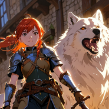Mastering “Bevel and Emboss” - From Beginner to Pro!
-
Posts
-
Care to detail why ? L2JHellas probably got the same issue, it's inherent to L2J if you don't rework Player intentions (and solving it with a Config < 500 attack is stupid, if it works for attack it works for other types of desires), also last time I checked L2JHellas he was using my changesets to fix its own stuff (which is ok, copy-paste my knownlist system which is 10y old is fine, but don't say it will act different since it's literally the same sub-system). About Lucera code source isn't available so it's easy to say it's better, internally you got no clue what is happening and RU forks got the "feeling" to get everything, but everything is half done, everytime I put an eye on such sources (whatever based on l2ru, they only know how to copy-paste each other). In the other hand, you seem to use aCis since years (I think I see your name since a decade, and you still use it since you made this topic : Be a little more appreciative about the work done, it's not only mine but my community aswell, and if you find something, consider to report rather than getting such an idiotic behavior. I understand you're not forced to share any type of fixes, and than people tend to feel superior when they fix something than aCis didn't yet fix. The thing is, for each bug you found, I found and fixed 10x more than you. 409 is way beyond 382 in all possible ways, if you believe the versus good for you, but don't make ppl believe it's the case, because it's not. There's at least 400+ fixed issues (and that's counting 10 issues by revision, which is kinda low) and entire new systems (spawns, SCHs, pathfind, whole AI implemented, Desire system,...).
-
better than using 409... Search for L2jHellas or Lucera and you won't have any headaches.
-
By Morrison2102 · Posted
General Trackers : IPTorrents invite IPTorrents account 1 tb TorrentLeech invite Torrentleech account 1 tb buffer InTheShaDow ( ITS ) account Acid-lounge invite Torrentday invite Crnaberza account Abn.Lol account Limit-of-eden account Norbits account Xspeeds account Xspeeds invite Bemaniso invite Wigornot account Bithumen invite Filelist account Funfile invite AvistaZ invite Potuk.net invite ResurrectThe.Net invite GrabThe.Info invite Greek-Team invite LinkoManija invite Fano.in account tracker.czech-server.com Speed.cd invite Arab-torrents.net account Arabscene.me account Scenetime account 4thd.xyz invite Btarg.com.ar account Dedbit invite Estone.cc account Speedapp invite Finvip invite Fluxzone account GigaTorrents account Gimmepeers account Haidan.video invite Mojblink account Mycarpathians invite Newinsane.info account Oscarworld.xyz account Peers.FM invite Pt.msg.vg account Ransackedcrew account Redemption invite Scene-rush account Seedfile.io invite Teracod invite Torrent.ai account Torrentmasters invite Ttsweb invite X-files invite X-ite invite Ncore account TorrentHR account Rptorrents account BwTorrents account Superbits invite Krazyzone account Immortalseed account Tntracker invite Pt.eastgame.org account Bitturk account Rstorrent account Tracker.btnext invite Torrent-turk.de account BeiTai.PT account Pt.keepfrds account 52pt.site account Pthome account Torrentseeds account Aystorrent account Blues-brothers.biz invite Divteam account Thesceneplace invite CinemaMovies.pl account Brasiltracker account Patiodebutacas account Newheaven.nl account Swarmazon.club invite Bc-reloaded account Crazyspirits account Silentground invite Omg.wtftrackr invite Milkie.cc invite Breathetheword invite Madsrevolution account Chilebt account Yubraca account Uniongang.tv account Frboard account Exvagos account Diablotorrent account Microbit account Carp-hunter.hu account Majomparade.eu account Theshinning.me account Youiv.info account Dragonworld-reloaded account Sharewood.tv account Partis.si account Digitalcore.club invite Fuzer.me account R3vuk.wtf invite Ztracker account 1 tb buffer 3changtrai account Best-core.info account Bitsite.us account Eliteunitedcrew invite Exitorrent.org account Tophos invite Torrent.lt account Sktorrent.eu account Oshen account Blackhattorrent account Pirata.digital account Esharenet account Ohmenarikgi.la Pirate-share account Immortuos account Kiesbits account Cliente.amigos-share.club account Broadcity invite Ilovetorzz account Torrentbytes account Polishsource account Portugas invite Shareisland account ArabaFenice account Hudbt.hust.edu.cn account Audiences account Nanyangpt account Pt.sjtu.edu.cn account Pt.zhixing.bjtu.edu.cn account Byr.pt invite Ptfiles invite Red-bits account Pt.hdpost.top account Irrenhaus.dyndns.dk (NewPropaganda) account Mnvv2.info (MaxNewVision V2) account 1ptba.com account Spidertk.top account Film-paleis account Generation-free account Aftershock-tracker account Twilightsdreams account Back-ups.me invite Sor-next.tk ( Spirit Of Revolution ) account Tfa.tf ( The Falling Angels ) account Hdmayi account S-f-p.dyndns.dk ( Share Friends Projekt ) account Unlimitz.biz account Pttime account St-tracker.eu account New-retro.eu account Zbbit account Tigers-dl.net account Jptvts.us account Lat-team account Club.hares.top account Falkonvision-team account Concen account Drugari account T.ceskeforum account Peeratiko.org account Zamunda.se account Central-torrent.eu account h-o-d.org account Torrentleech.pl account Demonoid invite Lst.gg account Fakedoor.store account LaidBackManor account Vrbsharezone.co.uk invite Torrenteros account Arenaelite account Datascene account Tracker.0day.community Tapochek.net invite Ptchina invite Lesaloon account Exyusubs account Therebels.tv account Ubits.club invite Zmpt.cc account Turktorrent.us account Dasunerwarte account Hawke.uno account Monikadesign account Fearnopeer account Alpharatio account Wukongwendao.top account Chinapyg account Azusa.wiki account Yggtorrent.top account Torrentdd account Cyanbug.net invite Hhanclub.top account Wintersakura.net account Xthor account Tctg.pm account Finelite invite Agsvpt.com account Pt.0ff.cc invite Qingwapt.com account Xingtan.one account Ptcafe.club invite Theoldschool.cc account W-o-t.pro account Coastal-crew.bounceme.net account Darkpeers.org account Pianyuan.org account Seedpool.org account Tempelbox account Pt.itzmx.com account Capybarabr.com account Itatorrents.xyz account Letseed.org account The-new-fun.com account Malayabits.cc account Trellas.me account Yu-scene.net account Futuretorrent.org account Bitpt.cn account Tocashare.biz account Movies Trackers : Anthelion account Pixelhd account Cinemageddon account DVDSeed account Cinemageddon account Cinemaz account Retroflix account Classix-unlimited - invite Movie-Torrentz (m2g.link) invite Punck-tracker.net account Tmghub account Tb-asian account Cathode-ray.tube account Greatposterwall account Telly account Arabicsource.net account Upload.cx account Crabpt.vip invite Onlyencodes.cc account Exyusubs account Hellashut.net invite Nordichd.sytes.net invite Locadora.cc account HD Trackers : Hdf.world account Torrentland.li account HdSky account Hdchina account Chdbits account Totheglory account Hdroute account Hdhome account TorrentCCF aka et8.org account 3DTorrents invite HD-Torrents account Bit-HDTV account HDME.eu invite Hdarea.co account Asiancinema.me account JoyHD invite HDSpace invite CrazyHD invite Bluebird-hd invite Htpt.cc account Hdtime invite Ourbits.club account Hd4fans account Siambit account Privatehd account Springsunday account Tjupt account Hdcity.leniter invite Ccfbits account Discfan account Pt.btschool.club account Ptsbao.club invite Hdzone.me invite Danishbytes account Zonaq.pw account Tracker.tekno3d account Arabp2p account Hd-united account Reelflix.xyz account Hdatmos.club account Anasch.cc invite Tigris-t account Nethd.org account Hd.ai invite Hitpt.com account Hdmonkey account Dragonhd.xyz account Hdclub.eu account Forum.bluraycd.com account Carpt account Hdfun.me invite Pt.hdupt invite Puntotorrent account Ultrahd account Rousi.zip account Bearbit account Hdturk.club account Asiandvdclub account Star-space.net account Nordicq.org account Hdkyl.in account Utp.to account Music Trackers : Dicmusic account Music-Vid account Open.cd account LzTr account ProAudioTorrents invite Jpopsuki invite TranceTraffic invite Audionews invite Kraytracker invite Libble.me invite Losslessclub invite Indietorrents.com invite Dimeadozen account Funkytorrents invite Karaokedl account zombtracker.the-zomb account Concertos account Sugoimusic account Satclubbing.club invite Metal.iplay invite Psyreactor invite Panda.cd account Adamsfile account Freehardmusic account Tracker.hqmusic.vn accouunt Twilightzoom account 3 tb buffer Hiresmusic account Metalguru account Musictorrents.org account Musebootlegs.com invite Zappateers.com account E-Learning Trackers : BitSpyder invite Brsociety account Learnbits invite Myanonamouse account Libranet account 420Project account Learnflakes account Pt.soulvoice.club account P2pelite account Aaaaarg.fail invite Ebooks-shares.org account Abtorrents account Pt.tu88.men invite Docspedia.world invite TV-Trackers : Skipthecommericals Cryptichaven account TV-Vault invite Shazbat.TV account Myspleen account Tasmanit.es invite Tvstore.me account Tvchaosuk account Jptv.club account Tvroad.info XXX - Porn Trackers : FemdomCult account Pornbay account Pussytorrents account Adult-cinema-network account Bootytape account 1 Tb buffer Exoticaz account Bitporn account Kufirc account Gaytorrent.ru invite Nicept account Gay-torrents.org invite Ourgtn account Pt.hdbd.us account BitSexy account Happyfappy.org account Kamept.com account Lesbians4u.org account Gaming Trackers : Mteam.fr account BitGamer invite Retrowithin invite Gamegamept account Cartoon/Anime/Comic Trackers : Animeworld account Oldtoons.world account U2.dmhy account CartoonChaos invite Animetorrents account Mononoke account Totallykids.tv account Bakabt.me invite Revanime account Ansktracker account Tracker.shakaw.com.br invite Bt.mdan.org account Skyey2.com account Animetracker.cc Adbt.it.cx invite Tracker.uniotaku.com account Sports Trackers : MMA-Tracker invite T3nnis.tv invite AcrossTheTasman account RacingForMe invite Sportscult invite Ultimatewrestlingtorrents account Worldboxingvideoarchive invite CyclingTorrents account Xtremewrestlingtorrents account Tc-boxing invite Mma-torrents account Aussierul invite Xwt-classics account Racing4everyone account Talk.tenyardtracker account Stalker.societyglitch invite Extremebits invite Rgfootball.net account F1carreras.xyz account Software/Apps Trackers : Brokenstones account Appzuniverse invite Teamos.xyz account Macbb.org account Graphics Trackers: Forum.Cgpersia account Gfxpeers account Forum.gfxdomain account Documentary Trackers: Forums.mvgroup account Others Fora.snahp.eu account Board4all.biz account Filewarez.tv account Makingoff.org/forum account Xrel.to account Undergunz.su account Corebay account Endoftheinter.net ( EOTI ) account Thismight.be invite Skull.facefromouter.space account Avxhm.se (AvaxHome) account Ssdforum account Notfake.vip account Intotheinter.net account Tildes.net invite Thetoonz account Usinavirtual account Hdclasico invite HispaShare account Valentine.wtf account Adit-hd account Forum-andr.net account Warezforums account Justanothermusic.site account Forbiddenlibrary.moe account Senturion.to account Movieparadise account Militaryzone account Dcdnet.ru account Sftdevils.net account Heavy-r.com account New-team.org account Ddl.tv account Filewarez.club account Hispamula.org account Hubwarez.tv account NZB : Drunkenslug account Drunkenslug invite Usenet-4all account Brothers-of-Usenet account Dognzb.cr invite Kleverig account Nzb.cat account Nzbplanet.net invite Ng4you.com account Nzbsa.co.za account Bd25.eu account NZB.to account Samuraiplace account Tabula-rasa.pw account Abhdtv.net account Abook.link account Comix.pw account House-of-usenet Secretbinaries.net account Vnext.to account Stockboxx.top account Prices start from 3 $ to 100 $ Payment methods: Crypto, Neteller, Webmoney, Revolut If you want to buy something send me a pm or contact me on: Email: morrison2102@gmail.com Discord: LFC4LIFE#4173 Telegram: https://t.me/LFC4LIFE4173 Skype: morrison2102@hotmail.com
-
-
Topics






.jpg.4a8af448ba34b409af662c668c0c5f45.jpg)






Recommended Posts
Create an account or sign in to comment
You need to be a member in order to leave a comment
Create an account
Sign up for a new account in our community. It's easy!
Register a new accountSign in
Already have an account? Sign in here.
Sign In Now